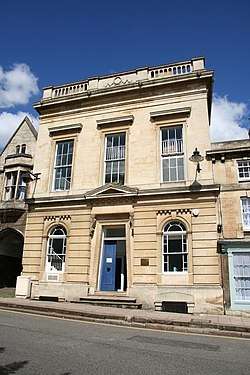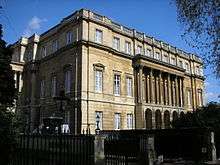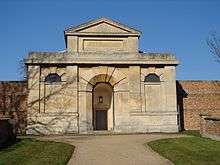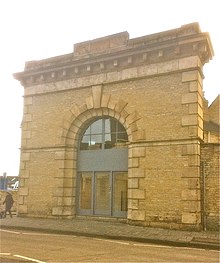Bryan Browning
Bryan Browning (1773–1856) was an English architect working in Stamford.
Bryan Browning | |
|---|---|
 Camera Obscura House, Stamford | |
| Born | 1773 Thurlby, Lincolnshire |
| Died | 1 October 1856 Stamford |
| Nationality | English |
| Occupation | Architect |
| Practice | First in partnership in London with George Woolcott, then by himself in Stamford and from 1847 in partnership with his son Edward Browning. |
Life

Bryan Browning was born at Thurlby in Lincolnshire in 1773. Nothing is known about his architectural training but in 1817 he made designs for the re-building of Ringwood vicarage in Hampshire. Between about 1820 and 1830 he worked in partnership with George Woolcott in Doughty Street as Builders and Surveyors. In this period Browning and Woolcott worked as contractors for a number of major building projects in London. This included the building of Lancaster House. They also built Strensham Court in Worcestershire, probably to designs by George Maddox. In 1821 Bryan Browning designed the Sessions House at Bourne, in Lincolnshire and in 1824 he was the architect for the House of Correction at Folkingham. By 1834 he had returned to Lincolnshire and was living at Northorpe near Bourne. He had moved to Stamford by 1838 where he was retained by the Marquess of Exeter and was being paid £180. In 1847, his son, Edward Browning, who had trained under George Maddox, joined the practice. The practice worked from Broad Street, Stamford. Bryan Browning died on 1 October 1856 and is buried in the cemetery there.[1]
Works
Public buildings
.jpg)

- 1821. Sessions House, Bourne, Lincolnshire
- 1824-5. House of Correction at Folkingham
- 1835. Stamford Workhouse
- 1842. Stamford Institution (Camera Obscura House)
School
- 1840-1 National School, Titchmarsh, Northamptonshire
Houses
- 1843. Barn Hill House, Stamford. Remodelled for Lord Exeter.
- 1846-48. Alterations to Apethorpe, Northants.
Rectories and vicarages
- 1833. Alwalton, Northamptonshire.
- 1835 Fletton, Hunts.
- 1838 Greatford, Lincolnshire.
- 1839 Deeping St James, Lincolnshire.
- 1840 Stoke Dry Rectory, Rutland
Miscellaneous

- 1845. Grant's Iron Foundry, Wharf Road, Stamford. Built for Lord Exeter. Only the monumental arch now survives. This was built in 1845 as the entrance to Grant's iron foundry and was designed by Bryan Browning. The site became Blashfield's Terracotta Works in 1858. In 1937 the arch was rebuilt several feet to the south and parallel with the road.[2][3]
References
- "Colvin" (1995), pg.172.
- Heritage Gateway
- ”Antram” (1989), pg. 713.
Literature
- Antram N (revised), Pevsner, N. & Harris J, (1989), The Buildings of England: Lincolnshire, Yale University Press.
- Antonia Brodie (ed), Directory of British Architects, 1834–1914: 2 Vols, British Architectural Library, Royal Institute of British Architects, 2001, Vol 1, pg. 280.
- Colvin H. A (1995), Biographical Dictionary of British Architects 1600–1840. Yale University Press, 3rd edition London, pg.172.